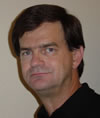AutomatedBuildings.com
Article - November 2002
[Home Page] |
[an error occurred while processing this directive]
(Click Message to Learn More) |
EMAIL INTERVIEW
Anno Scholten & Ken Sinclair
 Anno Scholten has been
involved in the commercial building systems industry for more than 20 years. He
is an executive founder and Vice President of eStructures Inc with a primary
responsibility for product development. Prior to eStructures, he was VP of
Engineering for CSI Control Systems International (now TAC).
Anno Scholten has been
involved in the commercial building systems industry for more than 20 years. He
is an executive founder and Vice President of eStructures Inc with a primary
responsibility for product development. Prior to eStructures, he was VP of
Engineering for CSI Control Systems International (now TAC).
Anno moved from Perth,
Australia to Dallas, Texas in 1994 to serve as Director of Product Development
for CSI. Before that, he worked for an Australian company EMS Energy Management
Services Pty. Ltd. that is now a subsidiary and regional headquarters for TAC.
His controls expertise
includes a joint patent for a Variable Air Volume environmental management
system that incorporates both fuzzy logic and LON technology. anno@estructures.com
Research and
Development in the Controls Industry
Sinclair:
How does new
technology evolve in the controls industry?
Scholten: Like
other industries, new controls technology has evolved along two distinct
paths. The first path introduces a radical new concept that is usually a
significant step-up in the technology. The second path produces many small
incremental improvements on the new technology introduced by the first path.
Progress on the two paths proceeds concurrently but at different rates.
Sinclair:
Give me an example of a technology on the
first path that has changed things significantly.
Scholten: The
most recent example is, of course, the Internet and specifically the Web
Browser User Interface. This is a good example of a technology created outside
the controls industry that has made a significant step-up in open User
Interface solutions for building systems. Since it's first introduction, many
companies have made continuing incremental improvements to the Web Browser as
a UI.
Sinclair:
Are there many new developments, it seems like a slow moving industry to many of
us?
Scholten: The
cycle of each path is very different and very dependent on the industry. In
the controls industry, the first path seems to cycle about every seven years
and the second cycle about every eighteen months. Most people typically see
the long cycles of the first path as the 'slowness' of the industry to develop
new technologies. Incremental improvements on the second path, no matter how
short, do not seem to contribute to a perception of fast moving developments.
Sinclair:
Who does these developments, corporations or research establishments?
Scholten: The
first path is usually driven by fundamental research initiatives conducted by
universities, research engineers and even backyard tinkerers.
Corporations use
well-defined product development processes to drive the second path.
Incremental improvements benefit greatly from market research and customer
feedback once a new concept was been introduced.
Sinclair:
Is this research normally commercially driven?
Scholten: Unfortunately,
here in the US the amount of funding for research is very low compared with
other countries. Therefore, new developments in the building systems industry
have happened because of shear tenaciousness and commitment by some dedicated
individuals. As a result, it is not very organized or rewarding for these
innovators.
[an error occurred while processing this directive]Sinclair:
What are the challenges for researchers?
Scholten: The
main challenge they face is finding a way to present their ideas to the right
audience. Unlike many other industries, there are currently no forums or
independent channels to which researchers working in the building systems
industry can present their latest work. This typically means that, at best, research
engineers' only opportunity is to present their initiatives to internal
members of the corporation for which they work. University funded researchers
and lone innovators have a much greater challenge.
Sinclair:
Is there anything in the future that will help this information to be better
distributed?
Scholten: There
are some interesting venues starting to happen, AutomatedBuildings.com is a
good example. The new BuilConn 2003 forum is another good opportunity.
BuilConn has recognized that there are many new developments being worked on
in building systems that would benefit by providing a 'no strings attached'
venue for the innovators to present their progress.
Sinclair:
What can we learn if we see these developments?
Scholten: Foremost,
of course, we will see many new ideas and future possibilities in the controls
industry that may not have seen the light of day previously. More importantly,
by providing rewarding forums for the presentation of new ideas we may
encourage more people to undertake research and development of their latest
inspiration. This would help reduce the seven-year cycle of the first path.
[an error occurred while processing this directive]
[Click Banner To Learn More]
[Home Page] [The
Automator] [About] [Subscribe
] [Contact
Us]
 Anno Scholten has been
involved in the commercial building systems industry for more than 20 years. He
is an executive founder and Vice President of eStructures Inc with a primary
responsibility for product development. Prior to eStructures, he was VP of
Engineering for CSI Control Systems International (now TAC).
Anno Scholten has been
involved in the commercial building systems industry for more than 20 years. He
is an executive founder and Vice President of eStructures Inc with a primary
responsibility for product development. Prior to eStructures, he was VP of
Engineering for CSI Control Systems International (now TAC).